I’ve been in Montreal for a week now, staying in the charming neighborhood of Plateau Mount Royal and spending full days of robotics training at the Canadian Space Agency.
I haven’t ventured far beyond the commute route so far, except for the brief stroll to nearby cafés for breakfast, a little daily ritual that has progressively shifted later in the mornings as I have slowly digested the six-hour time shift from Europe. I have taken great pleasure in exploring the little quaint streets flanked by trees and row houses, each with a unique façade and with an outdoor staircase leading to an independent entrance on the second floor. Straight or curved, simple or elaborate, rigorously in metal with open steps, these external staircases conjure up a dynamism that matches the colorful livelihood of the neighborhood.
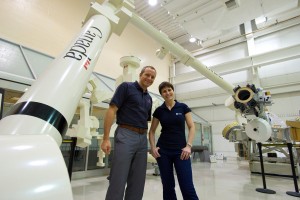
With Canadian colleague David Saint-Jacques and a real-size Canadarm2 mockup. Every boom is 7 meters long, but it's an amazingly light piece of hardware (Credit: CSA)
It’s a delightful way to start the day before making my way to the facilities of the Canadian Space Agency for training on the Space Station Robotic Manipulator System. Short: the SSRMS. For friends: the Canadarm2. In case you ever wondered how a 400-ton structure was put together on orbit, the short answer is: piece by piece, with the help of the SSRMS.
You can imagine the Canadarm2 as a robotic replica of your own arm in a bigger size. It has a shoulder, an elbow and a wrist. Like your arm, it has two straight booms between the joints. And like your arm it can bend the elbow and it can rotate shoulder and wrist in pretty much any orientation. In engineering terms it means that it has seven degrees of freedom, although we can lock one of degree of freedom to force the arm to move in a more controlled way. Station is precious; bumping into it is not an option.
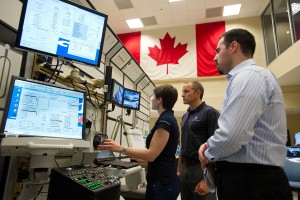
Working at the Robotic Work Station. The two monitors relate to the simulator and are not present on orbit. Instructos using to run the simulation (Credit: CSA)
To train future ISS crewmembers in SSRMS operations the Canadian Space Agency has Robotic Work Stations that are identical to the ones on orbit. There are hand controllers for translation and rotation, a computer and a control panel to configure the system and to input commands, and three monitors for camera images. There is no real arm, of course, but simulation software runs in the background and the camera views will show you exactly what you would see if you were flying the arm on orbit.
A typical simulator session might well start with what might look like playing with a toy. On a small-scale model of the robotic arm we reproduce the initial configuration based on the given deflections of each joint. I like to see it as a warm-up exercise for the brain.
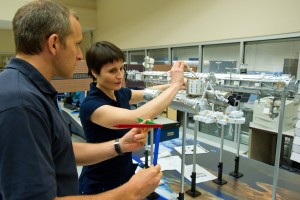
Placing the Canadarm2 on the ISS model in proper position and configuration. The prop David is holding is useful to visualize coordinate frames (Credit: CSA)
If you’re a model-builder you’ll love what comes next: to be able to visualize the arm movement with respect to the Space Station, we have a tremendously detailed rapid-prototyping model of the ISS right next to the simulator workstation. I find it an object of intrinsic beauty, I’ll confess. But it’s of course intended as a tool of visualization and as an aid in the extensive brain gymnastics to come: mentally flipping camera images, predicting how the arm movement will look from different points of views, identifying the best camera combination to monitor clearances from structure, determining hand controller inputs in different coordinate frames, visualizing joint movements – these are some of the tasks that are sure to keep your brain on its toes as you fly the arm.
After one week of training I am starting to be familiar with nominal basic SSRMS operations. I’m now looking forward to learning next week about off-nominal situations like singularities and self-collisions, as well as practicing free-flyer captures, which consist in maneuvering the arm to grapple a vehicle that is not attached to the Space Station.
You can expect free-flyer captures to become more and more frequent on ISS in the coming years. Not only astronauts will continue to capture and berth the Japanese resupply ship HTV, but they will soon start doing the same for the new US commercial resupply vehicles Dragon and Cygnus. First Dragon capture is coming up soon, and I think it will be a historic moment. Make sure to watch!










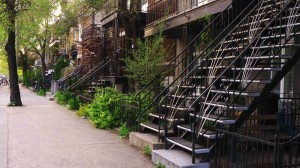
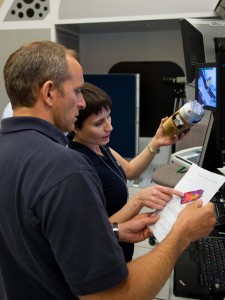
Discussion: 14 comments
Well, thanks again for all of this! No need to precise that it is really interesting, as usual. 😀 I am confused about one thing: all the 5 agencies involved have at least one module up there, right? And the facilities to be trained for a specific module are in the country which own the module, is that correct? But also, I’ve been told that basically people are working specifically in the module belonging to their country (and a little bit in others), so, do you actually need to be well trained on all of that?
Merci beaucoup !
We try to strike the right balance between specialization and cross-training 🙂
Robotics is definitely something that every NASA-ESA-JAXA-CSA astronaut is trained on, but different crewmembers will be assigned different tasks and might get some specific training in later stages.
Thanks Samantha for sharing your amazing experiences 🙂
Thanks for your interest and encouragement 🙂
Great Samantha! The model replica of the ISS is very detailed! Thanks for this part of your training so interesting! Good Work. 🙂
I’m glad you find it interesting. And yes, the model is stunning!
Why they call it ” Space Station Robotic Manipulator System”? is it really a robot for definition? what are the functions that are autonomous?
Thanks for your interest. The SSRMS is remotely controlled, it is not autonomous. That doesn’t make it any less a robot, I think.
In my child imagination a robot is an autonomous machine with artificial intelligence. But you are right, from italian wikipedia: “robòt, from the Czech word ‘robota’ that means “hard work”.
So many thanks for the information and good luck with the ROBOTA. Excuse for the double post on G+
Is very good to have someone like you to share these experiences, I wish you the best of luck 🙂
Yes – I remember how exciting it was to watch the videos of the Dragon capture – it really was a historic moment! The view that you describe remind me of what it was like learning to use 3D Studio max for animations – move it in the main window and everything in every other window moves in a different direction… that’s pretty amazing stuff that you guys practice doing that without bumping into the Space Station! How many hours of practice do you need in total before you are allowed to pilot the CanadArm for real? Also – how often do you have to do refresher training – or do you just train once and get to use it (that seems kind of risky with such an expensive and awesome piece of robotics :D)??
Hello Sarai, it’s an interesting comparison you make with 3D graphics software. Never thought about it.
Not sure what the total number of training hours on the arm is. For sure refresher training is scheduled regularly in the training flow. Also, before a major robotics operations – certainly before a free-flier capture – crew on ISS can refresh their skills with on-board training.
That sounds quite interesting – is the on-board training also a simulation, or do you practice actually using the arm? Also, are the controls designed for only one person, or could your instructor “hit the brakes” if you were about to make a mistake during training? Thanks again for sharing!
great! I will show cartoon of this great smart arm!